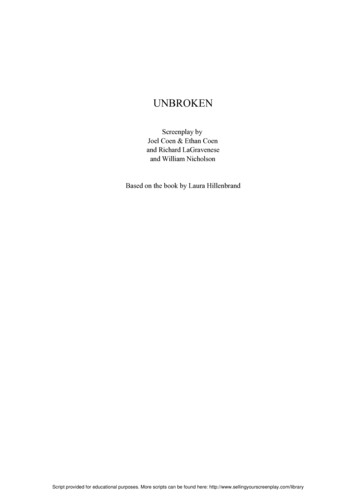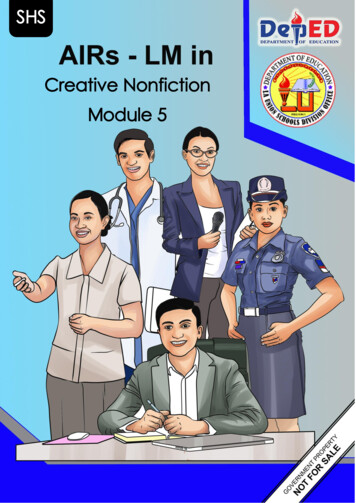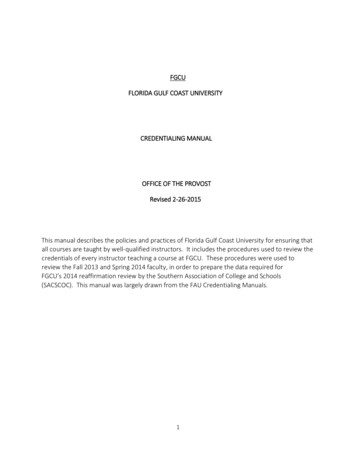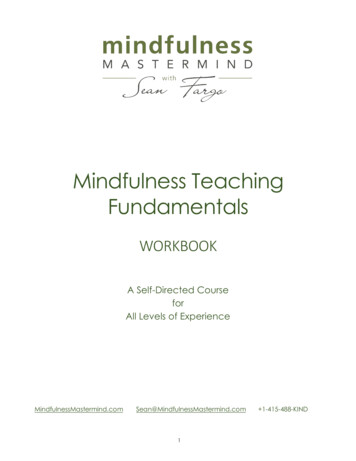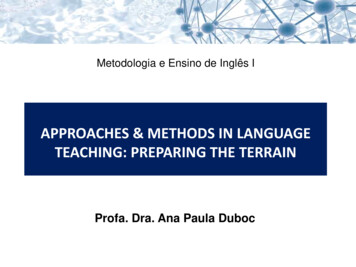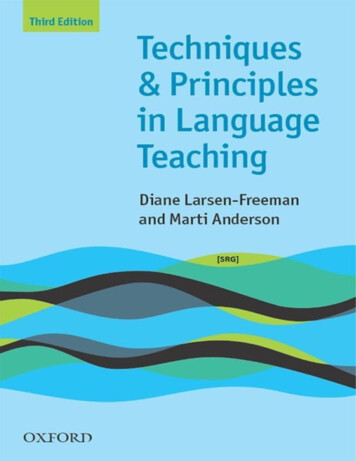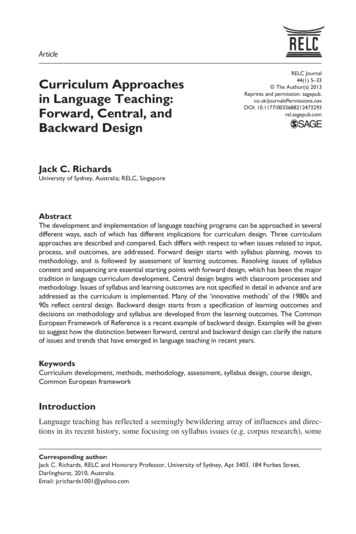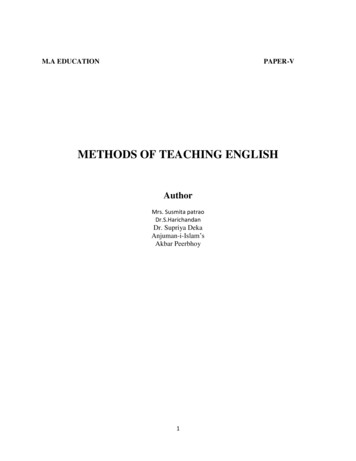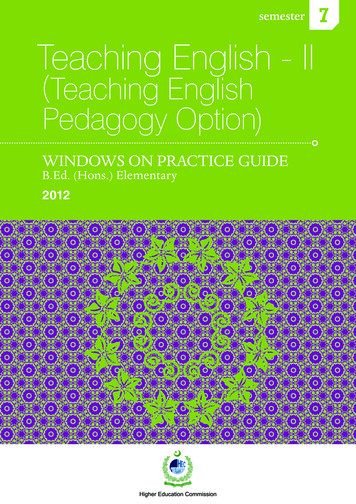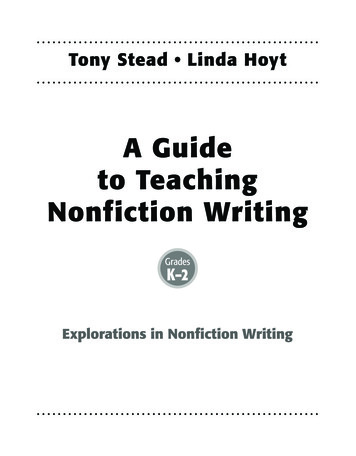
Transcription
Tony Stead Linda HoytA Guideto TeachingNonfiction WritingGradesK–2Explorations in Nonfiction Writing
firsthandAn imprint of Heinemann361 Hanover StreetPortsmouth, NH 03801-3912firsthand.heinemann.comOffices and agents throughout the world 2011 by Tony Stead and Linda Hoyt. All rights reserved.Except where noted, no part of this book may be reproduced in any form or by any electronic or mechanicalmeans, including information storage and retrieval systems, without permission in writing from the publisher,except by a reviewer, who may quote brief passages in a review.“Dedicated to Teachers” is a trademark of Greenwood Publishing Group, Inc.Cataloguing-in-Publication data for this book is available from the Library of Congress.A Guide to Teaching Nonfiction Writing, Grades K-2ISBN-10: 0-325-03775-2ISBN-13: 978-0-325-03775-2Explorations in Nonfiction Writing, Grade KISBN-10: 0-325-03774-4ISBN-13: 978-0-325-03774-5 (lesson book)ISBN-10: 0-325-01342-8ISBN-13: 978-0-325-01342-2 (kit)Explorations in Nonfiction Writing, Grade 1ISBN-10: 0-325-03777-9ISBN-13: 978-0-325-03777-6 (lesson book)ISBN-10: 0-325-02681-5ISBN-13: 978-0-325-02681-7 (kit)Explorations in Nonfiction Writing, Grade 2ISBN-10: 0-325-03780-9ISBN-13: 978-0-325-03780-6 (lesson book)ISBN-10: 0-325-03143-6ISBN-13: 978-0-325-03143-9 (kit)Cover photographs: Bill MillerDesign and production: Small PlanetPrinted in the United States of America1413121110VP123456
To all the teachers who have embraced nonfictionas the heartbeat of their writing program—Thank you.
AcknowledgmentsTeam Heinemann: You never fail to amaze with your ability to listen, to coach, and to help a visionbecome reality. Tina Miller, Charles McQuillen, Harvey (Smokey) Daniels, Deb Doorack, David Stirling,Cynthia Nye, Carolyn McGuire. What a team!Lynnette Brent: You are amazing. Thank you so much.Barbara Petruccio, Doreen Osmun, and fellow educators from Hudson, Ohio. Oh, my! Working withyou and sharing your celebrations of learning has been a joy. Thank you for all of the wonderful writingsamples and amazing moments with students.Kathy Porterfield, Lindy Sproul, Jennifer Patterson, Michael Shay, and teachers at Boones Ferry PrimarySchool, Wilsonville, Oregon. You offered counsel and professional thoughtfulness at a time when thisproject was but a dream. Thank you for your encouragement and generous sharing of student work.Jan McCall, Anne Pergiel, and Marie Davis at Kinnaman Elementary School. You joined the call when wehad little more than wet clay. Thank you for your faithful testing of lessons and feedback. You are the best!Barbara Coleman, Kristy Thomas, and teachers at Wingate Elementary School, Wingate, North Carolina.Thank you for testing lessons, reflecting on possibilities, and helping us find a path that took these lessonsto a higher level.Marie Govro and Leah Starkovich, trusted reviewers and amazing educators from Gilbert Park ElementarySchool, Portland, Oregon. Thanks for the feedback and the fabulous cookies!Jodi Wilson, Angela Duff, and Eba Farzana from Holmes Elementary School, Spokane, Washington. Youbelieve in possibility and it shows in the work of your writers. You raise the bar, open the door, and sethigh standards. The result is amazing.Ann Stewart, sharp-minded, kindhearted, and always focused on kids.Marlene Hill, treasured friend and passionate educator. Thank you for your contributions and sharedthinking.Grace Formica, Ileen Bichler, Maria Horvath, Jenny Malash, Odalis Neris, Sara Flores, Meredith Benvenuto,and the grade 1 team at PS 197, Bronx, New York. Your willingness to open up your classrooms andexperiment with nonfiction writing made this resource possible.Johanna Castronovo, Alice Lee, Fay Coccoli, Julie Cooke, Mary Murphy, Leonie Dodd, and the kindergarten,first-, and second-grade teachers at PS 105, Brooklyn, New York. The projects you produced with yourstudents clearly demonstrated that young children can achieve anything with the right scaffolds.Happy Carrico, Cecelia Holt, Noemi Uribe, Melissa Leonard, and the staff at E. P. Rayzor ElementarySchool, Argyle, Texas. We have learned so much from you. Your school has demonstrated the power ofinquiry-based learning in producing lifelong researchers and writers.Marcia Kellum and the team at Denton Independent School District, Texas. You have been pioneers insuccessfully integrating nonfiction into the everyday lives of your students. You’re truly inspirational.Adaire Wooding, Karen Flavin, Rhonda Wilhite, and the teachers from Alief Independent School District,Texas. What amazing projects your students produced!Cathy Duvall and the teachers from Fort Bend Independent School District, Texas. Your enthusiasm toembrace nonfiction was incredible.The teachers at Twin Valley School District in Pennsylvania. What remarkable projects you produced withyour students! Many thanks for your commitment to making nonfiction a joyous occasion for all yourstudents.Arlene Lackowitz, your photographs are appreciated!
A Guide toTeaching Nonfiction WritingCONTENTS1Rationale for Teaching Nonfiction Writing6Building a Culture of Inquiry and Research1118314047Understanding the Goals ofTeaching Nonfiction WritingEmphasizing the Writing ProcessSetting the Stage for Nonfiction Writing:Scaffolds for SuccessFocusing on Instruction:Explicit Supports That Lift Writing QualityReferences
Rationale for Teaching Nonfiction WritingExplorations in Nonfiction WritingWhen I write, I wonderWhen I write, I thinkWhen I write, I learnWhen I write . . .I wrap myself in the magic of nonfictionRationale for TeachingNonfiction WritingNonfiction writing used to be saved for genre studies in which young writerscreated a set of directions or engaged in crafting a report about animals.But, evidence now suggests that this limited view of nonfiction writing is"too little—too late!" We now know that informational literacy that engagesour youngest learners as readers and writers of nonfiction texts needs tobe an integral part ofevery learner’s schoolexperience from preschool onward (PurcellGates, Duke, Martineau,2007). We now knowthat forward-thinkingeducators of youngchildren weave explicitscaffolds for nonfictionreading and nonfictionwriting into the fabric ofdaily literacy instruction,making sure that childrenwrite for a wide variety ofpurposes and experience abroad array of nonfictiontext types (Hoyt, 2009,2004; Stead, 2007, 2002;Saunders-Smith, 2010,Glover, 2009).young children are“ Sincecurious about the world,nonfiction reading andwriting should be woventhroughout the curriculumfrom the minute they startschool. By beginningearly on, we are preparingyoung children fornonfiction material they willbe presented with and beexpected to generate asthey progress through the”grades into adulthood.— kelly davis,literacy coach,howard county,maryland1
2A Guide to Teaching Nonfiction WritingTeach Nonfiction Writing Explicitlylive in a world“ Childrenfull of information. Themost important thing wecan do is teach themto communicate in their”world.— barbarapetruccio,language arts/social studiescurriculumspecialist,Hudson, ohioNonfiction writing fills our lives. Everywhere we look there are newspapers,magazines, directions, street signs, recipes, letters, maps, menus, e-mails, Internetsites, and so on. As writers, we make lists, craft letters, send e-mails, provideexplanations, and jot notes. In the real world, we have clear purposes and selectthe text types that help us fulfill our goals for remembering, recording, andcommunicating to others. To be successful in school, in the workplace, and in ourpersonal lives, we must learn about this wide range of nonfiction text types so wecan navigate and create them with comfort and purpose—to gain control overthe unique structures, language, and visual features that comprise the heart ofnonfiction texts. It is interesting to note that while informational texts make upthe great majority of texts written and read by literate adults, far too few childrenare taught explicit strategies for reading and writing these text types (Barone andMandell-Morrow, 2002).Emphasize Nonfiction Writing—from the Beginningwe teach children“ Whenhow to write nonfiction, wetap into their passionatecuriosity about the worldaround them. No longerwill teachers hear thedreaded whine, “I don’tknow what to write about!”The endless list of topicsincluded in the world ofnonfiction is waiting forchildren with open armsand is accessible to”everyone!— kelly boswell,teacher/author,bozeman,The Common Core Standards (2010) along with grade-level expectations andstandards from most states now call for a strong emphasis on reading and writingnonfiction texts—from the beginning. This means that learners of all ages needto become acquainted with the structures and features of informational texts,both as readers and as writers. They need to develop strategies for using thosefeatures to enhance understanding and increase efficiency in seeking and recordinginformation and to communicate ideas. It was once thought that primary-gradelearners were too young for nonfiction writing, but now we know that is not true.Even kindergartners love learningabout the world while they arelearning to read and learning towrite. Nonfiction topics appealto children’s intrinsic sense ofwonder and fuel a natural desire tounderstand and to learn.montanaAs nonfiction researchers andwriters, our youngest learnersbecome thoroughly engaged inidentifying and using nonfictiontext features such as labels, bullets,arrows, cross-section diagrams,and bold words. They findenormous purposein capturing their learning inlabeled diagrams, charts, posters,and student-authored books.
Rationale for Teaching Nonfiction Writing3With nonfiction literacy in mind, we would expect to see primary writers engagedin research using artifacts, live animals, photographs, high-quality nonfictionreading materials, listening centers, and computers. We would expect to seethese young learners recording information in pictures, in words, and in runningsentences. We would expect them to read and write in collaboration with partners,take great pride in sharing their writing with each other, and enthusiasticallygenerate questions that fuel more reading, more research, and more writing!Believe That They Can!We know that humans want to write. Early humans carved messages on the wallsof their caves and on stone tablets because of their innate desire to create messagesfor others to read. And, many of us can tell stories of our own children marking upthe walls of our homes because they have such a strong desire to “write.” As earlyas 1966, the seminal research studies of Dolores Durkin determined that youngchildren are actually ready to write before they are ready to read and that emergentreaders benefit greatly from attempts at writing, especially when the writing isbased upon real-world experience.The first challenge is to believe that a kindergartner or first or second grader canresearch and can learn to craft quality nonfiction selections. If we believe in them,and set the bar high withexplicit modeled writingand coaching, even ouryoungest learners will beable to reach astonishingheights as nonfictionwriters.The feedback fromprimary teachers whohave taken the leap andimmersed themselvesand their students innonfiction writing hasbeen overwhelminglypositive. They all reportthat their studentsare writing more andshowing greater levels ofaccomplishment than theydreamed could be possible.am so excited about“ Ihowthe children arewriting, especially incomparison to years past.My kindergarteners areconfident with severaltext types and absolutelylove to write. We havelists, notes, and multipage books that look likethey were done by mucholder students. Thankyou for helping me tobelieve. . . . They are moreaccomplished writers andI am a more accomplished”teacher.— sandy gordon,kindergartenteacher,Hudson, ohio
4A Guide to Teaching Nonfiction WritingJust Do It!hardest thing was“ Thelearning to trust mystudents. I was so afraidthat they wouldn’t write orthat the writing wouldn’tbe good. All it took wasan interesting topic, a bitof modeled writing on achart, and they were off”and running.— AndreaThompsomon,first-gradeteacherDonald Graves was often heard sharing the story of a time when he gave paper andpencils to three-year-olds, simply saying, “You may write on this.” The three-yearolds dove in with enthusiasm and great abandon, producing writing-like scriptand then proudly reading their writing to one another. There was no concern thatthese writers would write like this forever; instead there was celebration of whatthey could do. The enthusiasm of these emergent writers was a perfect pathway forinstruction and growth.As we launch experiences with nonfiction writing, it is important to rememberthat children do not need to have correct spelling, complete sentence structures,deep content knowledge, or well-developed writing traits in place before theybegin to engage as nonfiction writers. They will develop these essential skills as anatural extension of modeled writing, coaching conferences, revising, editing, andpresenting their work. They WILL learn as they go. With each successive writingexperience, writing skills will grow and children’s writing will gain sophistication.The key is: Don’t expect perfection—expect growth. Once you get your studentsstarted with nonfiction writing, there will be amazing opportunities for growthand development. Do lots of modeling and take time to think aloud as you writeunder the watchful eyes of your students. Let them hear what is in your mindas you capture an interesting fact on paper, insert a label on a diagram, or listthe attributes of a tree frog. Show them again and again how you write, reviseAll writers, even those who are most vulnerable, benefit from the concept developmentand language acquisition that go hand in hand with nonfiction writing.
Rationale for Teaching Nonfiction Writingby choosing a better word, edit by remembering to put a period at the end of asentence. At the right developmental moment, your models will “stick.” Celebrateeach moment of growth knowing that when your students write tomorrow, theywill do even better. Spelling, sentence structure, and traits will develop—hand inhand—within the context of the instructionally rich writing opportunities youprovide. So “just do it!” Leap in and get started.5Language“ EnglishLearners learn languagebest when it is embeddedin meaningful context.When ELLs read high-Be Confident That Vulnerable LearnersCan Succeed as Nonfiction Writersinterest books aboutIt is helpful to remember that in early childhood, understanding builds fromconcrete experience. It is through real experiences with real things that concepts,understanding, and language are acquired. When young children get to touch,think, talk, and wonder, they feel a stronger sense of connection to their learningand move forward with a powerful sense of intrinsic motivation. For these reasons,nonfiction writing is a perfect entry point for special education learners, studentslearning English as an additional language, and learners with limited academiclanguage and experience.discuss their reading toscience, social studies,and language arts,build oral language, andthen respond to learningthrough different kinds ofwriting activities, they gainthe academic languagethey need for school”success.— drs. yvonne anddavid freeman,In the nonfiction writing classroom, there is a sense of energy as writers observe,think together, and connect with their subject. This classroom often erupts withexcitement as researchers and writers share their observations and factual learning.In this classroom, learning floats on a sea of academic talk that supports and liftscontent understanding and language.The emphasis on visual literacy, collaboration, and modeled writing in thenonfiction writing classroom offers important systems of support for learners whoneed additional scaffolding to reach their highest levels of potential.For example, Sketch to Stretch, a TESOL-endorsed strategy, is often used duringresearch so students can represent their learning through a sketch or a labeleddiagram. With Sketch to Stretch, the academic vocabulary is highlighted andthe visual representation of the facts helps learners access the content throughmultiple systems of communication (Hoyt, 2009). Visual texts such as this scaffoldcontent understanding, build academic vocabulary, and support even the mostvulnerable learners toward success with nonfiction writing.authors ofnumerousbooks onsupportingenglishlanguagelearners
6A Guide to Teaching Nonfiction WritingBuilding a Culture ofInquiry and ResearchResearch and data gathering need to be positioned at the very center of anonfiction writing program, as children must learn how to acquire the facts thatwill fuel their work as writers. But it is important to remember that each time wetake a walk, stopping to look closely at ants scurrying in and out of their burrows,or taking time to examine the fragile pollens clustered at the heart of a daisy, weare conducting research.Questioningyou give children the“ Ifopportunityto explore andask questions, their levelof understanding and thequality of their nonfictionwriting will far surpasswhat would have beenaccomplished through”typical direct instruction.— melissaleonard, firstand secondgrade teacher,denton, texasQuestions empower researchers. Research and questioning are inseparablepartners in the nonfiction writing classroom. Whether young learners areresearching the parts of a flower or the process of using ice and rock salt tochill ice cream, questions should be flowing in a constant stream of engagedwonder. For young writers, questions are a significant device for seeking tounderstand their world. Primary-grade learners need to understand that it isgood to ask questions and wonder collaboratively with their learning partners.They need to understand that their questions will lead them to more researchand to deeper learning. It is interesting that many states now have standardsrequiring students to generate questions on a topic and then follow their ownline of questioning with research and nonfiction writing. So fire up thosequestions and keep them rolling!Personal ExperienceWith our youngest readers and writers, the first and perhaps mostsignificant source of information is personal experience. Those experiencesmay be part of their prior knowledge or built through hands-on experimentsand observations that you have provided for your students. To createa culture of inquiry and an understanding that real life is filled withopportunities for research, it is important to label these observations andlife experiences "research." When you gather your students to observechanging weather patterns, notice the intricate webbing spun by a spider,study the veins in a leaf, or plant seeds, tell your students that this isresearch. Label it! Show your researcher-writers how to gather data, recordfacts, make notes, create labeled diagrams, and record the importantlearning that is at the tips of their fingers. Then, invite them to pick up theirpencils and join you in recording their research.
Building a Culture of Inquiry and Research7School-Based Sources for ResearchWe know that it is not likely that your students will be able to have hands-onexperience with a polar bear, to touch the ridged surface of a glacier, or to wigglethrough the jungle with a giant anaconda. So we also need to be sure writersare skilled in gathering information from realia, print sources, video, audioprogramming, and Internet research.always talk about“ Teachersmaking writing authentic.Nonfiction writing can’t”help but be authentic.— noemi uribe,first- andsecond-gradeRealiaRealia is the next best thing to real-life experience. Real fruits, vegetables, plants,animal hides, turtle shells, fish tanks, fossils, andso on provide rich opportunitiesfor hands-on research, questioning,and language building. This isparticularly important for studentswho are learning English as anadditional language. For theselearners, firsthandexperience and realiaprovide the strongestpossible foundationfor the development ofacademic language andconcepts. For all learners,realia adds a sense ofexcitement and wonderthat can be far moredifficult to achieve with apicture or written text.Lots of Books on Lots of TopicsThe classroom library is central to success with nonfiction writing. Each classroomshould be brimming with nonfiction texts that both inform and invite readers intothe magic of their pages. Building a robust classroom library is a career-long effort,but working steadily at it, adding resources year by year, will contribute much toyour rich learning environment. For temporary resources, don’t forget to takeadvantage of your school and local libraries, your school or colleagues’ collections,and other contributions. We highly encourage you to examine your state standardsfor science and social studies to ensure that you have wonderfully rich and enticingresources devoted to those topics. We want to be sure that nonfiction writing is notseen as an add-on curriculum but rather as a natural extension of the topics anddisciplines you need to cover to help your students progress toward standards.teacher,denton, texas
8A Guide to Teaching Nonfiction WritingGroup Books by TopicMany teachers find it helpful to group nonfiction books according to topic sowriters can easily find collections of books on penguins, bears, solar energy,celebrations around the world, and so on. It is also helpful to identify books thatare written with a purpose in mind: books that describe, instructions, scientificexplanations, persuasion, and nonfiction narratives such as biographies or BatLoves the Night by Nicola Davies.When books and other resources are organized by topic, researchers find iteasier to locate information. Inviting displays pique interest in a topic.Multi-Level Theme SetsAs we embrace increasing levels of diversity in our classrooms, it is critical thatwe provide students with opportunities to engage with books and resources thatentice and fuel their sense of wonder, but we also need to offer resources at their“just right” reading level. Multi-level theme sets are a support system that providesa range of books and other resources on a focused topic, while offering a range ofdifficulty levels for reading and inquiry (Hoyt, 2003).If you use a crate with hanging folders inside, your multi-level theme set can easilyinclude multiple-copy sets of leveled selections, magazines, read-aloud selections,pages printed from the Internet, recorded books and CDs for listening, DVDs toplay on the computer, and so on. Multi-level theme sets keep topics at the forefrontwhile enabling you to better meet the literacy learning needs of your students bygiving them resources that are accessible to them as readers.
Building a Culture of Inquiry and ResearchAs you build your multi-level theme sets, it is important to indicate reading levelin such a way that it is not evident to your students. Mark books with a colorcoded set of dots, for example, using one to five green dots for A-E (A 1 greendot, B 2 green dots, and so on) and one to five blue dots for F–J, and so on. Wewould never want students to feel limited by a perception that they are a “levelD” reader and can therefore only interact with level D books. The levels will assistyou in matching children to books for instruction, but we also want to ensurethat your writers can and do feel free to interact with books that intrigue them,as there is much to be learned from pictures. And, research suggests that whenyoung children have multiple text experiences related to the same topic, the coreacademic vocabulary they build enables them to read increasingly more difficulttexts related to the topic. With concepts and key vocabulary in hand, children whomight normally read at that level D can move quickly into more complex readingselections on the topic.9need to“ Childrenchronicle their knowledgein sequences, lists,descriptions, explanations,labels, captions, and more.What they see, know,and wonder should cometo life as they researchand construct nonfiction”texts.— dr. gailsaunders-smith,author ofnon-fiction textThe following is a small sample of what a multi-level theme set on animals mightinclude.Leveled Books for ResearchLevelTitlePublisherALife in a PondNewbridgeBAnimals of the RainforestLook at the AnimalsRigbyBenchmarkCKoalasAnimals in the DesertHow Animals MoveAnimals at NightRigbyRigbyNational GeographicNational GeographicDAnimals HideUnder the IceNewbridgeRigbyECaterpillar DiaryColorful AnimalsRigbyRigbyFA Frog Has a Sticky TongueFantastic FrogsNational GeographicRigbyGHow Do Frogs Grow?ChimpanzeesNewbridgeRigbyHPiranhasRigbyIThe Speedy CheetahNational GeographicJAnimal MysteriesAnimal ArmorRigbyNational GeographicLBaboon TroopsMountain GorillaRigbyHeinemann ClassroomMLife Cycle of a FrogHeinemann Classroomstructuresfor bettercomprehensionand response
10A Guide to Teaching Nonfiction WritingIn addition to leveled books, you’ll also want to collect other accessible, themerelated resources like those that follow.Additional Resources for Instruction and Research StationsResourceTitle (Series)Author/PublisherBooks for Read-Aloud andLearning from VisualsAnimals Nobody LovesSeymour Simon/ChronicleBooksFrog (See How They Grow)DK PreschoolActual SizeSteve Jenkins/Houghton MifflinBooks for ChildrenBat Loves the Night (Read and Wonder)Nicola Davies/CandlewickYoung ExplorerNational GeographicExplorerNational GeographicZoobooksWildlife Education, Ltd.Your Big BackyardNational Wildlife FederationRanger RickNational Wildlife FederationBig BooksWhat Do Animals Need?BenchmarkBooks for a Listening CenterAnimal HabitatsNational GeographicWordless TextA Dog’s LifeNational GeographicMagazines
Understanding the Goals of Teaching Nonfiction WritingUnderstanding theGoals of TeachingNonfiction WritingUnderpinning every strong nonfiction writing curriculum is a commitment toincreasing writing volume across the curriculum, to understanding purpose andtext types, to exploring and using nonfiction text features, and to striving forcritical and visual literacy.Writing VolumeIt is essential that we increase writing volume across the curriculum. It hasbeen well proven that writing influences content retention, boosts acquisitionof academic vocabulary, and enhances reasoning ability (Marzano, 2008; Hoyt,2007; Stead; 2002). So, it makes good sense to write in response to read-aloud,math, science, social studies, small-group literacy instruction—every segmentof the learning day. When children write across the curriculum, the writing isnaturally and authentically nonfiction in focus.students write“ Whenmore frequently, theirability to think, reason,analyze, communicate,and perform on testswill improve. Writing inWith increasing writing volume and extensive experiences in mind, primarygrade writers can and should write at every available opportunity—creatinglabeled diagrams of plant growth, writing letters to a partner explainingwhat they learned in math, crafting directions for a project in art,making a list of resources needed for a unit of study in science, or writing"From the Desk of " notes about an experience at a learning center.Kindergarteners can write or illustrate sticky-note book reviews for theirfavorite books, create a persuasive poster reminding others to cover asneeze, or write a set of directions together during guided writing. Extensivecross-curricular immersion in nonfiction writing helps first and secondgraders understand that writing helps us to remember and to think moredeeply, while stretching the range of text types that they can control.Research and Nonfiction WritingIn addition to extensive, cross-curricular writing experiences, youngwriters also need opportunities to slow down and to explore a specific texttype within the context of the writing workshop. With an intensive writingexperience, writers take time to closely examine the internal workings of aspecific text type and engage in research on topics of personal interest duringan extended writing unit.every curricular area,using many different texttypes, is critical to student”achievement.— Dr. DouglasReeves, Centerfor PerformanceAssessment, inGreiner, "ElevenResearchbased Tips forImproving WritingInstruction," 200711
12A Guide to Teaching Nonfiction Writingnever met a student“ I’vewho didn’t feel like he orshe could write nonfiction. . . whether it was a list,labeling pictures, a note,or a letter. I often let mystudents write my notesto the office, custodians,librarian, and otherteachers. They are alwayshappy to deliver their notesand get a response to their”writing.— Noemi Uribe,first- andsecond-gradeteacher,Denton, TexasAn extended writing unit stretches over time—taking from a week to a month—asnonfiction writers investigate, gather facts, and prepare to carry a piece of writingacross the entire writing process. Beginning writers learn to think about why theyare writing, who the audience might be, and what kind of nonfiction text wouldbest support their work (Stead, 2002). In an extended unit, where research andnonfiction writing come together, writing can at times be messy as young writersgather data and communicate it in sketches, notes, and lists. It can be focused aswriters closely examine nonfiction mentors that are exemplars of the text type theywill be creating.An extended nonfiction writing unit is filled with deep and long-lasting learningbecause, over time, children take on many roles. They cast themselves as observers,watching as their teacher thinks aloud and creates a model of the focus text type.They are careful listeners, noticing how the teacher verbally cross-checks to ensurethat the modeled writing has the same features and structures as the mento
are taught explicit strategies for reading and writing these text types (Barone and Mandell-Morrow, 2002). emphAsize nonfiction writing— from the Beginning The Common Core Standards (2010) along with grade-level expectations and standards from most states now call for a strong emphasis on reading and

